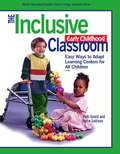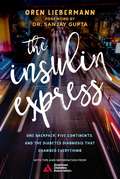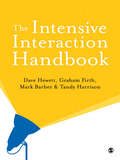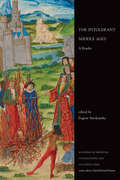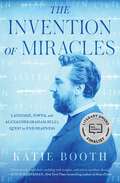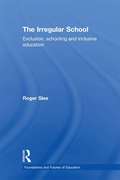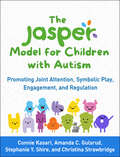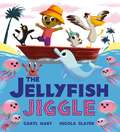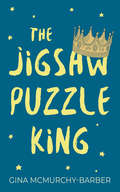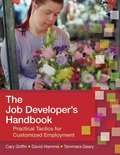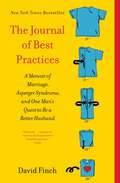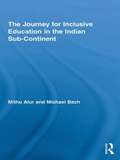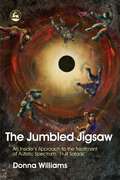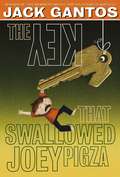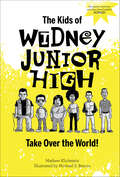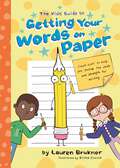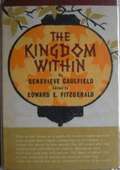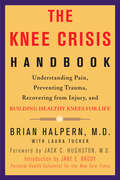- Table View
- List View
The Inclusive Corporation
by Griff HoganA disability handbook for business professionals. The author of this book donated a digital copy of this book. Join us in thanking Griff Hogan for providing his accessible digital book to this community.
The Inclusive Early Childhood Classroom: Easy Ways to Adapt Learning Centers for All
by Patti Gould Joyce SullivanThis resource manual on how to adapt regular curriculum activities for children with special needs offers concrete suggestions that are easy to implement, giving teachers the tools to turn their classrooms into effective learning environments for all students. The goal of the authors is to help children with special needs gain the opportunity to learn new skills and concepts by providing teachers, therapists, and parents with simple modifications to help children focus on the activities, materials, and social interactions of the classroom. Many of the modifications suggested in this book are also useful and interesting to children without special needs, so that no one child feels different or inferior in the classroom. Chapters describe and suggest practical ways to adjust centers and classroom routines so thatallchildren can learn and be kept involved in developmentally appropriate activities. The book discusses six categories of special needs in relation to featured chapter topics; categories of special needs include: developmental delays, orthopedic impairments, pervasive developmental disorder and autism, attention deficit hyperactivity disorder and behavioral issues, motor planning problems, and visual impairments. For teachers, therapists, and parents-especially those with children of special needs.
The Influence of Parental Attitudes and Social Environment on the Personality Development of the Adolescent Blind
by Vita Stein SommersThe author's experience with visually handicapped children and young adults in schools is richly used in this study of the influence Of parental attitudes and social environment on the personality development of the adolescent blind.
The Insulin Express: One Backpack, Five Continents, and the Diabetes Diagnosis That Changed Everything
by Oren LiebermannA travel memoir through thirty countries, a thousand insulin injections, and one man’s journey from despair to confidence. With tips and information from the American Diabetes Association.In the middle of a yearlong backpacking trip around the world with his wife, Oren Liebermann is teaching English to young Buddhist monks in Pokhara, Nepal, when his body begins to fail him. He is constantly thirsty and exhausted, and by the time he steps on a scale, he has lost forty-five pounds. At a local clinic, a doctor gives him a diagnosis that will change his life forever: "I’m sorry to tell you, my friend, that you are a diabetic.”Devastated, Liebermann is trapped in a freezing hospital room, trying to recover enough to fly home. His friends and family urge him to call off the rest of his trip. He had quit his job as a TV news reporter for this dream-come-true journey, but the nightmare diagnosis has thrown his world into disarray. However, Liebermann and his wife, Cassie, make a decision. They have an adventure to finish, and he has the rest of his life to live.Bold, raw, and poignantly candid, The Insulin Express tells the story of what happens when the best-made travel plans are subject to the ever-present chaos of life, and how a major setback can turn into the opportunity of a lifetime. Despite struggling with a chronic disease that almost kills him in the Himalayas, Liebermann hikes along the Great Wall of China, conquers the Inca Trail to Machu Picchu, and sips cobra whiskey in Laos. What begins as a travel chronicle across thirty countries transforms into a single journey of resilience and self-discovery-going from hopelessly lost and then wonderfully found.
The Intensive Interaction Handbook
by Dave HewettThe only guide you need to read on the Intensive Interaction approach returns for its second edition, this time with its founder, Dave Hewett, as the Editor. The Intensive Interaction approach has spread around the world and has been hugely influential in developing and teaching communication techniques with individuals who have severe learning difficulties and autism. This straightforward, no-nonsense handbook contains: - 2 new chapters: The Intensive Interaction Outcomes Reporter; and Autism and Intensive & Intensive Interaction and more able people; - photo stories demonstrating the approach in practice; - links to external videos presenting the photo stories in greater depth. More information on the Intensive Interaction community and approach can be found on dedicated social media pages, and at https://www.intensiveinteraction.org/
The Intensive Interaction Handbook
by Dave HewettThe only guide you need to read on the Intensive Interaction approach returns for its second edition, this time with its founder, Dave Hewett, as the Editor. The Intensive Interaction approach has spread around the world and has been hugely influential in developing and teaching communication techniques with individuals who have severe learning difficulties and autism. This straightforward, no-nonsense handbook contains: - 2 new chapters: The Intensive Interaction Outcomes Reporter; and Autism and Intensive & Intensive Interaction and more able people; - photo stories demonstrating the approach in practice; - links to external videos presenting the photo stories in greater depth. More information on the Intensive Interaction community and approach can be found on dedicated social media pages.
The Intensive Interaction Handbook
by Mark Barber Tandy Harrison Mr Dave Hewett Graham FirthIntensive interaction is an approach to teaching the pre-speech fundamentals of communication to children and adults who have severe learning difficulties or autism, and who are still at an early stage of communication development. This book is a practical guide to help those wishing to implement intensive interaction in their setting, and it provides detailed advice and step-by-step guidance as well as a consideration of all the issues associated with carrying out this approach. It considers: - preparing for intensive interaction - observing intensive interaction in progress - doing intensive interaction at home and at work - teamwork - wellbeing - record-keeping This book is a straightforward guide for anyone wanting to use intensive interaction with people with severe and complex learning difficulties, people who have very severe learning difficulties, profound and multiple learning difficulties, multi-sensory impairments, and people who have a diagnosis of autism.
The Intentional IEP: A Team Approach to Better Outcomes for Students and Their Families
by Stephanie DeLusseyLearn how to put together IEPs with the power to make a real difference for students The Intentional IEP shows special education teachers how to successfully collaborate with all stakeholders—parents or guardians, general ed teachers, therapists, and beyond—to work toward students’ success. Too many of us aren’t trained to write the Individualized Education Programs that help millions of students with thrive in school. This book fills that training gap, explaining the importance of assembling an IEP team and inviting this team to confront and improve its current processes and habits to make IEP writing simpler and more effective. With all the pressures that educators are under, it’s easy to cut corners when it comes time towrite IEPs. Writing them in isolation, leaving them to the night before, making decisions without consulting data and research, letting family collaboration fall to the wayside—most special educators have made these mistakes at some point. The Intentional IEP equips you with the resources you need to feel confident in approaching IEPs the right way, including prioritizing the many competing demands you face so you can find the capacity to show up for your students. This book offers: Clear, step-by-step solutions for all IEP members that can easily be implemented at any time during the school year Collaboration strategies for IEP teammates to rely on one another for expert and professional knowledge Tools and reproducibles to strengthen practices and overcome common hurdles Direct advice from a veteran special education teacher who has seen what a difference collaboration in the IEP can make for studentsThe Intentional IEP is a timely resource for special education teachers, general education teachers, and support staff, as well as teachertraining programs. Parents and guardians with students will also benefit from this clearly written guide to the IEP.
The Intolerant Middle Ages: A Reader (Readings in Medieval Civilizations and Cultures)
The Intolerant Middle Ages is a collection of primary sources on the history of persecution. The goal of the book is to highlight instances of persecution and violence, as well as those relatively rare but significant episodes of toleration, toward an intentionally broad spectrum of people who existed at the margins of medieval society: heretics, Jews and Muslims, the poor, the displaced and disabled, women, and those deemed sexually deviant. The volume also presents a more geographically diverse Middle Ages by including sources from Central and Eastern Europe as well as the Mediterranean. Sources are organized in thematic chapters, covering everything from "Heresy and Inquisition" to "Disease and Disability." Each document is preceded by a brief introduction and followed by questions for discussion, making The Intolerant Middle Ages an excellent entrance into the lives and struggles of minorities in the medieval world.
The Invention of Miracles: Language, Power, and Alexander Graham Bell's Quest to End Deafness
by Katie BoothFinalist for the PEN/Jacqueline Bograd Weld Award for Biography Finalist for the Mark Lynton History Prize &“Meticulously researched, crackling with insights, and rich in novelistic detail&” (Steve Silberman), this &“provocative, sensitive, beautifully written biography&” (Sylvia Nasar) tells the true—and troubling—story of Alexander Graham Bell&’s quest to end deafness. &“Researched and written through the Deaf perspective, this marvelously engaging history will have us rethinking the invention of the telephone.&” —Jaipreet Virdi, PhD, author of Hearing Happiness: Deafness Cures in History We think of Alexander Graham Bell as the inventor of the telephone, but that&’s not how he saw his own career. As the son of a deaf woman and, later, husband to another, his goal in life from adolescence was to teach deaf students to speak. Even his tinkering sprang from his teaching work; the telephone had its origins as a speech reading machine. The Invention of Miracles takes a &“stirring&” (The New York Times Book Review), &“provocative&” (The Boston Globe), &“scrupulously researched&” (Pittsburgh Post-Gazette) new look at an American icon, revealing the astonishing true genesis of the telephone and its connection to another, far more disturbing legacy of Bell&’s: his efforts to suppress American Sign Language. Weaving together a dazzling tale of innovation with a moving love story, the book offers a heartbreaking account of how a champion can become an adversary and an enthralling depiction of the deaf community&’s fight to reclaim a once-forbidden language. Katie Booth has been researching this story for more than fifteen years, poring over Bell&’s papers, Library of Congress archives, and the records of deaf schools around America. But she&’s also lived with this story for her entire life. Witnessing the damaging impact of Bell&’s legacy on her family would set her on a path that overturned everything she thought she knew about language, power, deafness, and the telephone.
The Irregular School: Exclusion, Schooling and Inclusive Education (Foundations and Futures of Education)
by Roger SleeShould disabled students be in regular classrooms all of the time or some of the time? Is the regular school or the special school or both the solution for educating students with a wide range of differences? Inclusive education has been incorporated in government education policy around the world. Key international organisations such as UNESCO and OECD declare their commitment to Education for All and the principles and practice of inclusive education. There is no doubt that despite this respectability inclusive education is hotly contested and generates intense debate amongst teachers, parents, researchers and policy-makers. People continue to argue over the nature and extent of inclusion. The Irregular School explores the foundations of the current controversies and argues that continuing to think in terms of the regular school or the special school obstructs progress towards inclusive education. The book contends that we need to build a better understanding of exclusion, of the foundations of the division between special and regular education, and of school reform as a precondition for more inclusive schooling in the future. Schooling ought to be an apprenticeship in democracy and inclusion is a prerequisite of a democratic education. The Irregular School builds on existing research and literature to argue for a comprehensive understanding of exclusion, a more innovative and aggressive conception of inclusive education and a genuine commitment to school reform that steps aside from the troubled and troubling notions of regular schools and special schools. It will be of interest to all those working and researching in the field of inclusive education.
The JASPER Model for Children with Autism: Promoting Joint Attention, Symbolic Play, Engagement, and Regulation
by Connie Kasari Amanda C. Gulsrud Stephanie Y. Shire Christina StrawbridgeThis full-color, clinician-friendly manual is the authoritative guide to implementing the Joint Attention, Symbolic Play, Engagement, and Regulation (JASPER) intervention. With a strong evidence base, JASPER provides a clear, flexible structure to bolster early skills core to social communication development. The authors show how to assess 1- to 8-year-olds with autism spectrum disorder (ASD), set treatment targets, choose engaging play materials, tailor JASPER strategies to each individual, and troubleshoot common challenges. In a convenient large-size format, the manual features case examples, learning exercises, and reproducible clinical tools. At the companion website, clinicians can download and print the reproducible materials as well as a supplemental annotated bibliography.
The Jellyfish Jiggle
by Caryl HartGet ready to scuttle, swim, wiggle and jiggle in this delightful rhyming story which gets children reading and moving along!When we were at the beach today, a little crab came by."Come scuttle with me," said the crab. "Scuttling's fun, let's try!"Whirl and wiggle! Whirl and wiggle!Let's SCUTTLE and SNAP to the Jellyfish Jiggle!Learn to move like your seaside friends at the beach and under water! Dive with the penguin, rock the pelican's boat and wiggle, jiggle and giggle with the jellyfish! Everyone can join the fun in or out of the water!Features a main character with a prosthetic limb showing all the fun exercise moves.This fantastic water-themed story from Caryl Hart and Nicola Slater, the duo behind The Safari Stomp, is perfect for getting little ones excited about swimming.
The Jigsaw Puzzle King
by Gina McMurchy-BarberBeing yourself isn’t always easy. When you’re new in school, all you want is to fit in. When eleven-year-old Warren and his family move to a new city, his twin brother, who has Down syndrome, attracts too much attention for Warren’s liking. Bennie’s different and doesn’t care about it. But while Bennie may be oblivious to those who are curious or uneasy with him, Warren notices every smirk, comment, and sideways glance. Warren is weary of flip-flopping between trying to be just like everyone else and being the protective brother of a boy with special needs. Sometimes he thinks his life would be easier if he had no brother. But what he really needs is to stop worrying about what other people think.
The Job Developer's Handbook: Practical Tactics for Customized Employment
by Cary Griffin David Hammis Tammara Geary<p>One of the most practical employment books available, this forward-thinking guide walks employment specialists step by step through customized job development for people with disabilities, revealing the best ways to build a satisfying, meaningful job around a person's preferences, skills, and goals. Internationally known for their innovative, proactive job development strategies, the authors motivate readers to expand the way they think about employment opportunities and develop creative solutions. <p>Readers will get fresh, proven tips and ideas for every aspect of job development for youth and adults with significant support needs: <p> <li>discovering who the person is and what he or she really wants <li>ensuring goodness of fit between employer and employee <li>finding—or creating—"hidden jobs" in smaller companies <li>empowering people through resource ownership (investing in resources that employers need) <li>skillfully negotiating job duties while managing conflicts that might arise <li>creatively maximizing benefits using social security work incentives <li>encouraging family support while respecting the individual as an adult</li> <p> <p>To make each part of job development easier, the book arms readers with practical content they can really use: easy-to-follow, step-by-step guidelines; checklists of critical questions to answer; success stories in both urban and rural settings; and sample scenarios, dialogues, and interview questions. <p>Equally useful to veteran professionals and those just starting out, this compelling guidebook breathes new life into the job development process and helps readers imagine a wider world of employment opportunities for people with disabilities.</p>
The Journal of Best Practices: A Memoir of Marriage, Asperger Syndrome, and One Man's Quest to Be a Better Husband
by David Finch*A New York Times Bestseller* A warm and hilarious memoir by a man diagnosed with Asperger syndrome who sets out to save his relationship.Five years after David Finch married Kristen, the love of his life, they learned that he has Asperger syndrome. The diagnosis explained David&’s ever-growing list of quirks and compulsions, but it didn&’t make him any easier to live with. Determined to change, David set out to understand Asperger syndrome and learn to be a better husband with an endearing zeal. His methods for improving his marriage involve excessive note-taking, performance reviews, and most of all, the Journal of Best Practices: a collection of hundreds of maxims and hard-won epiphanies, including &“Don&’t change the radio station when she&’s singing along&” and &“Apologies do not count when you shout them.&” David transforms himself from the world&’s most trying husband to the husband who tries the hardest. He becomes the husband he&’d always meant to be. Filled with humor and wisdom, The Journal of Best Practices is a candid story of ruthless self-improvement, a unique window into living with an autism spectrum condition, and proof that a true heart is the key to happy marriage.
The Journey for Inclusive Education in the Indian Sub-Continent (Routledge Research in Education)
by Mithu Alur Michael BachDespite national and international commitments to Education for All, and the Millennium Development Goals to assure universal primary education by 2015, over 90% of children with disabilities remain excluded from regular education in countries of the south. This book describes a three decade-long change initiative in India to enable children with disabilities to move from segregation and exclusion to inclusive education, and draws lessons for confronting global exclusion. It examines the barriers to inclusion of children with disabilities in the Indian sub-continent, estimated at 4% of the population, or 40-50 million children, and implications of the systemic failure within a human rights framework. The book concludes with setting this initiative in a broader context of inclusive education development efforts, and identifies lessons it provides for a global development agenda for inclusive education, including the importance of ensuring strategies that are culturally appropriate and context-specific.
The Julian Chapter: A Wonder Story
by R. J. PalacioA New York Times bestsellerA brand new, exclusive chapter from the bestselling, award-winning, and critically acclaimed novel Wonder.Over 1 million people have read Wonder and have fallen in love with Auggie Pullman, an ordinary boy with an extraordinary face. Now readers will have a chance to hear from the book's most controversial character--Julian. From the very first day Auggie and Julian met in the pages of the #1 New York Times bestseller Wonder, it was clear they were never going to be friends, with Julian treating Auggie like he had the plague. And while Wonder told Auggie's story through six different viewpoints, Julian's perspective was never shared. Readers could only guess what he was thinking.Until now. The Julian Chapter will finally reveal the bully's side of the story. Why is Julian so unkind to Auggie? And does he have a chance for redemption?
The Jumbled Jigsaw: An Insider's Approach to the Treatment of Autistic Spectrum `Fruit Salads'
by Donna WilliamsThe Jumbled Jigsaw exposes autism spectrum disorders (ASDs) not as single entities but as a combination of a whole range of often untreated, sometimes easily treatable, underlying conditions. Exploring everything from mood, anxiety, obsessive-compulsive and tic disorders to information processing and sensory perceptual difficulties, including dependency issues, identity problems and much more, Donna demonstrates how a number of such conditions can combine to form a 'cluster condition' and underpin the label 'autism spectrum disorder'. Donna Williams encourages and empowers families to look at what they can do to change their child's environment to address anxiety, overload and other issues. She also gives carers the necessary information to navigate the booming autism marketplace and demand the right tools for the job. The author also challenges professionals to adopt a multi-disciplinary approach to identifying and treating the cluster conditions that make up an autism spectrum diagnosis, and to improve service delivery to those in need. The Jumbled Jigsaw is a call to modern society to take responsibility and accept diversity. It is written in a very human and user-friendly way for parents and for Auties and Aspies themselves, but it is also aimed at carers, professionals, policy-makers and service providers.
The Juvenile Court System
by Donna LangeWhen young people commit crimes, they often do not know what to expect next. Will they go to prison like an adult? What programs are there to help them? What people will teach them to make better choices next time? How will they be treated in the juvenile court system? As you read the story of Jeremy, a boy who is caught vandalizing his school, you too will learn the answers to these questions. You will discover what laws govern how young people are treated, and find out about the juvenile court system's processes. You'll find out what happens when young people commit crimes--and how they can get back on track.
The Key That Swallowed Joey Pigza (Joey Pigza Series #5)
by Jack GantosThe fifth and final book in the groundbreaking Joey Pigza series brings the beloved chronicle of this wired, wacky, and wonderful boy to a crescendo of chaos and craziness, as everything goes topsy-turvy for Joey just as he starts to get his feet on the ground. With his dad MIA in the wake of appearance-altering plastic surgery, Joey must give up school to look after his new baby brother and fill in for his mom, who hospitalizes herself to deal with a bad case of postpartum blues. As his challenges mount, Joey discovers a key that could unlock the secrets to his father's whereabouts, a mystery that must be solved before Joey can even hope that his broken family might somehow come back together―if only it doesn't pull him apart first.
The Kids of Widney Junior High Take Over the World!
by Mathew KlicksteinThe Kids of Widney Junior High Take Over the World!is a fun-filled story for middle grade readers ages 8 to 12 inspired by the real-life Kids of Widney High, a rock band made of members with developmental disabilities, and offers readers fresh thoughts on how to better interact with classmates and friends living with disabilities.
The Kids’ Guide to Getting Your Words on Paper: Simple Stuff to Build the Motor Skills and Strength for Handwriting
by Lauren BruknerDoes your hand ache when you write? Packed with fun and simple ideas to help kids feel good about writing, this handwriting book with a difference helps children embed the strength and skills they need to get the most out of their written work, at home and school!From different kinds of cushions, hand warm-ups, and cool eye scan exercises, and pencil grips to yoga balls in cardboard boxes, personalized activity binders, playdough, lego, and Velcro on pencils, this book is filled with fun stuff to help kids focus, get stronger, and be in control of their writing. The strategies in the book are accompanied by cartoon-style illustrations, and the author includes useful tips for parents and teachers as well as handy visual charts, a quiz to identify areas of most difficulty, and checklists for children to track their own progress.Armed with the strategies and exercises in this book, kids will be well on their way to writing with greater ease, and the positive self-esteem that goes along with that. Suitable for children with writing difficulties aged approximately 7 to 12.
The Kingdom Within
by Genevieve CaulfieldGenevieve Caulfield became blind as an infant, and was educated at the Perkins and Overbrook Schools for the Blind before attending college. When she was seventeen she became passionately interested in Japan, and determined to work there as a teacher. This memoir describes her long and careful preparations for her move to Japan, and her 14 years there as a teacher of English. In 1937, as Japan went to war in Manchuria and its relations with the United States deteriorated, Caulfield relocated to Thailand, where she established that nation's first school for blind children. Along the way Caulfield made innumerable friends, adopted a Japanese daughter, and raised her twin grandchildren after her daughter's tragic death. Life in Thailand during World War II is vividly portrayed in this memoir. This is a straightforward account by a woman of enormous determination and ability.
The Knee Crisis Handbook: Understanding Pain, Preventing Trauma, Recovering from Injury, and Building Heal thy Knees for Life
by Brian Halpern<p>Ever sustained a knee injury? Want to prevent one? Whether you're young and actively involved in sports, an enthusiastic weekend warrior, or someone who's simply getting older and whose body is changing, The Knee Crisis Handbook by Brian Halpern, M.D. will show you how to take care of your knees. <p>You'll learn what to do if you sustain an injury, how to prevent a repeat injury, and how to help yourself avoid injury in the first place.Inside you'll find: * Sport-specific knee injury prevention tips * Advice on caring for your knees when you're young, older, or even pregnant * What to look for when choosing a physician and physical therapist * Treatment options, including acupuncture and other complementary medicine therapies * Medications: what you should and shouldn't take * What you can expect from surgery and recovery * How to avoid surgery * Complete exercise programs

